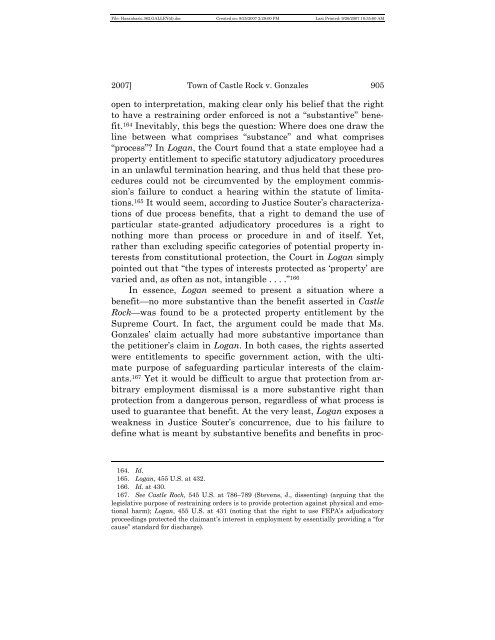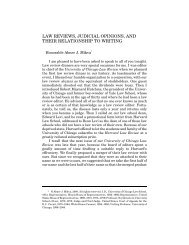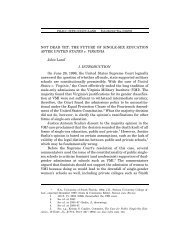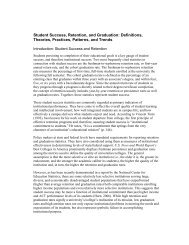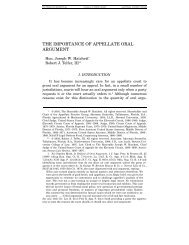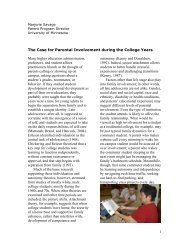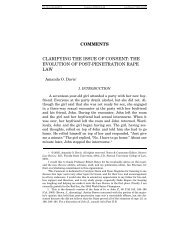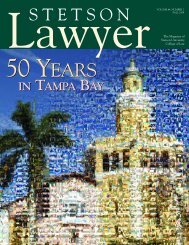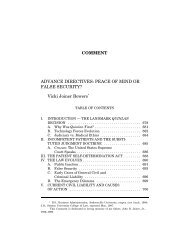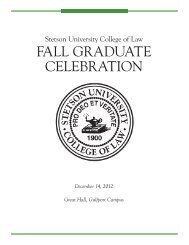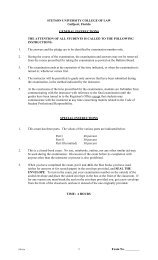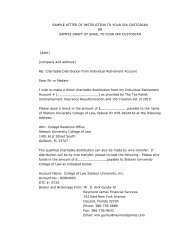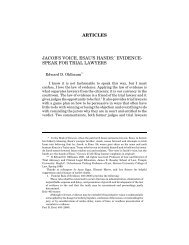TOWN OF CASTLE ROCK v. GONZALES: THE ... - Stetson University
TOWN OF CASTLE ROCK v. GONZALES: THE ... - Stetson University
TOWN OF CASTLE ROCK v. GONZALES: THE ... - Stetson University
You also want an ePaper? Increase the reach of your titles
YUMPU automatically turns print PDFs into web optimized ePapers that Google loves.
File: Hasanbasic.362.GALLEY(d).doc Created on: 9/25/2007 2:29:00 PM Last Printed: 9/26/2007 10:35:00 AM2007] Town of Castle Rock v. Gonzales 905open to interpretation, making clear only his belief that the rightto have a restraining order enforced is not a “substantive” benefit.164 Inevitably, this begs the question: Where does one draw theline between what comprises “substance” and what comprises“process”? In Logan, the Court found that a state employee had aproperty entitlement to specific statutory adjudicatory proceduresin an unlawful termination hearing, and thus held that these procedurescould not be circumvented by the employment commission’sfailure to conduct a hearing within the statute of limitations.165 It would seem, according to Justice Souter’s characterizationsof due process benefits, that a right to demand the use ofparticular state-granted adjudicatory procedures is a right tonothing more than process or procedure in and of itself. Yet,rather than excluding specific categories of potential property interestsfrom constitutional protection, the Court in Logan simplypointed out that “the types of interests protected as ‘property’ arevaried and, as often as not, intangible . . . .” 166In essence, Logan seemed to present a situation where abenefit—no more substantive than the benefit asserted in CastleRock—was found to be a protected property entitlement by theSupreme Court. In fact, the argument could be made that Ms.Gonzales’ claim actually had more substantive importance thanthe petitioner’s claim in Logan. In both cases, the rights assertedwere entitlements to specific government action, with the ultimatepurpose of safeguarding particular interests of the claimants.167 Yet it would be difficult to argue that protection from arbitraryemployment dismissal is a more substantive right thanprotection from a dangerous person, regardless of what process isused to guarantee that benefit. At the very least, Logan exposes aweakness in Justice Souter’s concurrence, due to his failure todefine what is meant by substantive benefits and benefits in proc-164. Id.165. Logan, 455 U.S. at 432.166. Id. at 430.167. See Castle Rock, 545 U.S. at 786–789 (Stevens, J., dissenting) (arguing that thelegislative purpose of restraining orders is to provide protection against physical and emotionalharm); Logan, 455 U.S. at 431 (noting that the right to use FEPA’s adjudicatoryproceedings protected the claimant’s interest in employment by essentially providing a “forcause” standard for discharge).


